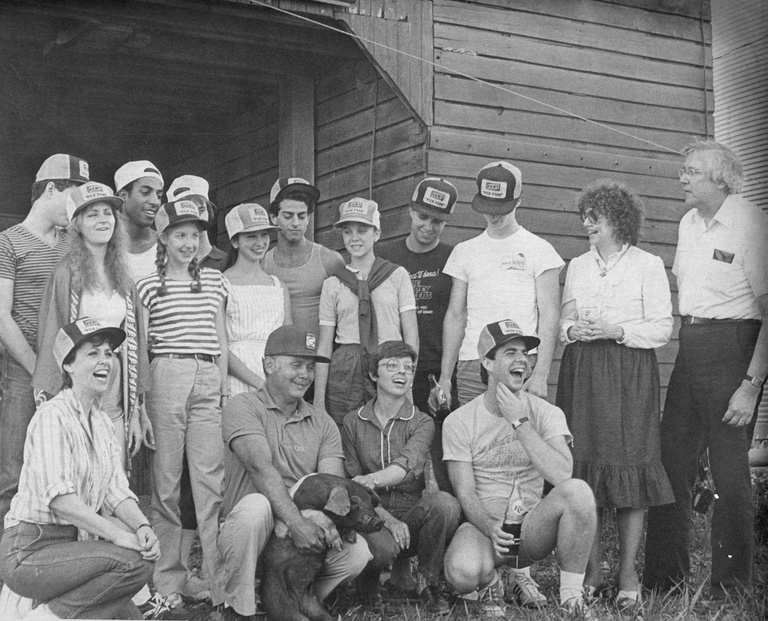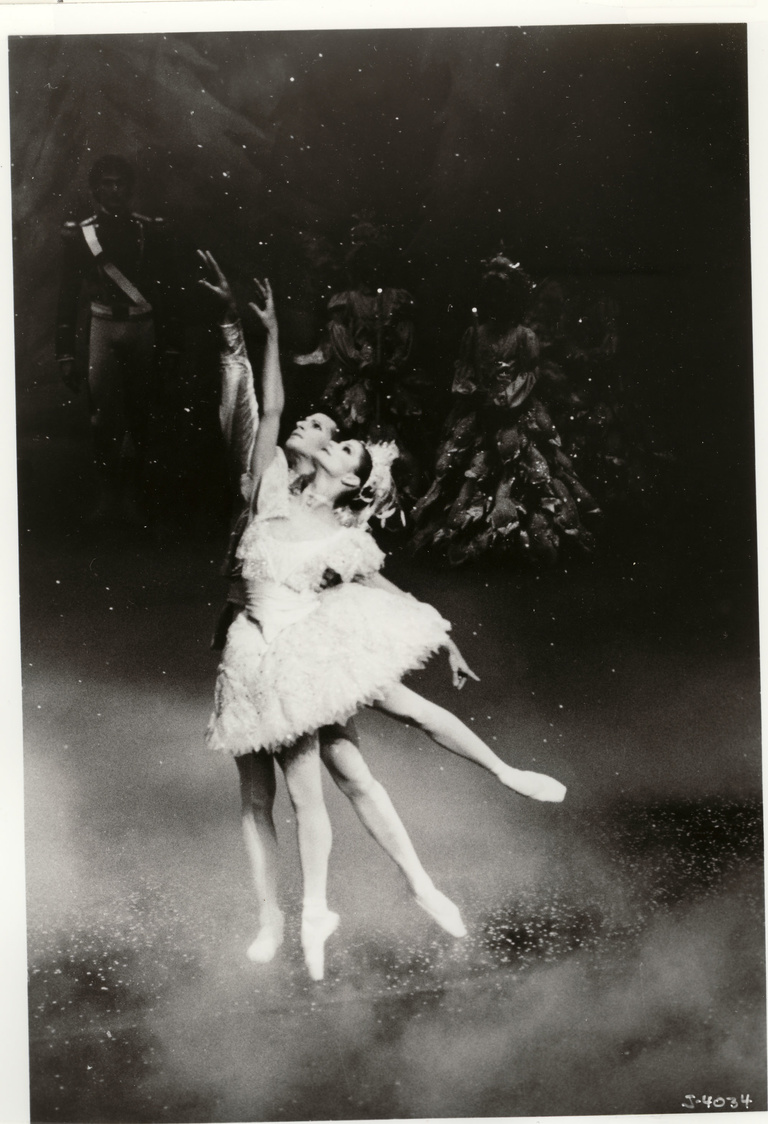On Feb. 25, 1986, Hancher Auditorium hosted the world premiere of its first commissioned work, the Joffrey Ballet’s The Heart of the Matter, which The New York Times said was “bound to be one of the season’s most important ballets.”
Hancher Executive Director Chuck Swanson says that night marked the beginning of a new creative future for the performing arts venue, which has gone on to commission 108 works to date.
“After the performance, we had a champagne toast in the lobby—the dancers, the staff, and the community,” says Swanson, who started as Hancher’s business manager the summer before the premiere at the University of Iowa. “I’ll always remember how special it felt that together we helped create this piece of work. It was the launch of something that we knew was going to be an important part of our role in the years to come.”

Since that evening, along with serving as a presenter of the performing arts, Hancher has become nationally known as a creative center whose commissions serve as a springboard for new works—many of which have been performed around the world. Its latest commission, Cirque Éloize’s Hotel, will be performed Oct. 5 at Hancher.
“Through a commission, the presenter can bring to the table the wherewithal, the inspiration, and the support to challenge an artist to do something new,” says Paul Brohan, programming director for Hancher. “We also have the opportunity to connect artists who may have real impact together and help them develop work that they may not be able to accomplish individually. Those types of commissions are exciting as well.”
Swanson says commissioning is just one way in which Hancher contributes to the university’s mission.
Cirque Eloize’s Hotel
(Hancher co-commission)
When: 7:30 p.m. Oct. 5
Where: Hancher Auditorium
Tickets: Buy tickets through the Hancher Box Office. $25 to $45 adults; $10 to $40 students; $10 to $22 youth. Learn more.
“The University of Iowa’s mission has three prongs—teaching, research, and service,” Swanson says. “Our mission is right in line with the university’s. Commissioning is the research, or discovery, part.”
Brohan agrees, pointing out that major research universities such as the UI are committed to the discovery of new knowledge.
“Helping the development of new work as part of a creative process is as much a part of research and creation as in the hard sciences,” Brohan says. “Commissioning at Hancher is a testament to the ongoing impact the University of Iowa has made and continues to make to the performing arts worldwide.”
At times, commissions involve more areas of campus than just Hancher. Two examples are 2002’s Sun Rings, by composer Terry Riley for the Kronos Quartet, and 2010’s Eye Piece, by Rinde Eckert. Sun Rings, based on sounds of space collected over 40 years by UI Professor of Physics and Astronomy Donald Gurnett, toured the world and ultimately was dedicated to Gurnett, whose “brilliant mind” Riley said “shared with us some of the universe’s secrets.”
Meanwhile, Eye Piece involved a much wider campus collaboration. For the music-theater piece that explores the loss of vision, UI alumnus Eckert crafted the script based on teaching sessions and interviews he collected from patients, families, doctors, and medical students at the UI Carver Family Center for Macular Degeneration. Students in the departments of theater, dance, and music were cast for the performances.
“Over the hundreds of years that there have been institutions of higher learning, people working in one sphere of scholarly endeavor have been attracted to the work of others, and they have seen parallels in the work of others,” says Edwin Stone, professor of ophthalmology and visual sciences and director of the UI Institute for Vision Research and the Carver Family Center for Macular Degeneration. “I think this project arose naturally from that sort of environment.”
Stone says artists have a special way of getting to the heart of things that are important to society.
“Few people in my generation went into medicine thinking they were making or delivering a product. That sort of thinking is offensive to us,” Stone says. “We feel that we are playing a fundamental role in society, helping our fellow man.
“Artists can capture the soul of medicine and present it to people in an attractive way instead of talking about it in a context of what the current governmental structure is or isn’t going to do. The arts can do that, and I think we need that more today than we’ve needed it in a long time.”
Hancher Auditorium commissions
Hancher Auditorium has commissioned or co-commissioned 108 works that have been performed or are planned to be performed between 1986 and 2020.
• 55 pieces in music
• 37 pieces in dance
• 16 pieces in theater
Read the full list of Hancher commissions and co-commissions.
Stone and Swanson say the project changed how those involved looked at medicine and disabilities.
“Medical students said they would never look at a patient the same way again. And students who played these roles said they would never look at a person with disabilities in the same way because they walked a bit in their shoes,” Swanson says. “This work impacted them forever. When you can use commissioning as a way to further the academic role that Hancher plays here at the University of Iowa and impact the lives of students, it makes it an even richer experience.”
“It’s the poster child for what commissioning should be,” Brohan adds.
Swanson and Brohan say that much about the commissioning process has changed over the years, but one thing has remained constant: at the center is a relationship. Commissioning can be a tool to help build a relationship between artist and presenter, or it can further cement a long-term relationship—such as that between the Joffrey Ballet and Hancher.
The storied partnership between Hancher and the Joffrey dates back to 1974, when the Joffrey first performed in the then two-year-old auditorium. The Heart of the Matter, by choreographer James Kudelka for the Joffrey, in 1986 was followed the next year by perhaps Hancher’s most famous commission: the Joffrey Ballet’s version of The Nutcracker, which the company performed every December for the next 28 years. Those ballets were followed by Billboards, featuring the music of Prince, in 1993, and a new version of The Nutcracker in 2016.

Brohan says commissioning requires a commitment from both parties.
“It’s a commitment to the artist and the new work, but it’s also a commitment the artist is making to the community and the presenter in advancing the mission and priorities of the university,” Brohan says.
In Hancher’s early years of commissioning, Swanson says an artist would come up with an idea and approach Hancher, which would then raise money.
“But over the years, it has become more participatory,” Swanson says. “We’re not making decisions in terms of costumes and lights, but we’re more of a partner in terms of communication and discussion along the way. And the artists are engaging more with the community. I’d say the majority of our artists do more than just the performance. We’re always looking at how we can connect them with the university to enrich the educational experience of students.”
Commissioning also is no longer solely a financial investment as it also can involve physical support, such as space for artists to work on new performances.
“That’s lovely too,” Swanson says. “We have a beautiful space, and space can be hard to come by for some companies. They can come here and get help with technical aspects or put together final touches. And we get to feel we’re a part of it, to feel the beginnings of it.”
A commission is like any sort of investment: some have great returns, others less so. The success of a commission can be measured in many ways.
“It depends on the priorities for the piece,” Brohan says. “There are times a commission is incredibly important because it catapults an artist in a new direction and you were part of bringing that new vision or new voice to reality. There are times—and Eye Piece was a good example—when the impact of what an artist was able to do on campus, across campus, and across disciplines makes it a success because that was the intention.”
While most are meant to have a lifespan beyond their premiere, sometimes commissions are designed to be one-time events. Hancher in 2013 commissioned San Jose Taiko, an arts organization dedicated to the Japanese art of taiko drumming, to perform and Eckert to recite work written for a ceremony that paid tribute to three workers who died during construction of the original Hancher building—destroyed in a 2008 flood—and that dedicated the ground of the new Hancher to safety.
“It was so moving; there wasn’t a dry eye in the group,” Swanson says. “To me, that was one of our most successful commissions due to the emotional impact of it.”
An event being planned for summer 2020 will offer a unique opportunity for collaboration between artists and the campus community. The Big Splash! will celebrate the river at the center of the community and the 100th anniversary of the UI’s IIHR—Hydroscience & Engineering, a global leader in fluids-related research and education. The event will include performances and activities, including a whimsical parade on the Iowa River with floats created by commissioned artists and professionals.
“We need to come up with our own word for it, because it’s not a commission in a true sense, but it’s bringing artists together in an almost festival atmosphere to create an experience and not just a new work,” Brohan says.
Such partnerships illustrate how commissioning continues to evolve.
“We must challenge ourselves as to how we approach the commissioning process,” Swanson says. “There are many ways in the future that we can support artists and new work. Artists have their passions, and across this campus we have so many people to whom we can connect them.”